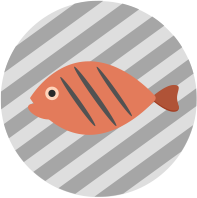Colorado Stops a Multistate Salmonella Outbreak Linked to Seafood
During foodborne disease outbreaks, investigation and response partners must work collaboratively to stop the current outbreak, determine how contamination occurred, and implement measures to prevent future outbreaks. When an outbreak is particularly challenging, such as a multistate outbreak with exposures occurring in a single state, it is crucial that all partners work together closely and maintain clear, bi-directional communication to respond effectively and efficiently.
Linking 2020 and 2021 Salmonella Thompson outbreaks

On August 5, 2021, the Colorado Department of Public Health and Environment (CDPHE), along with the Centers for Disease Control and Prevention (CDC), U.S. Food and Drug Administration (FDA), and public health and regulatory officials in several states, opened a multistate outbreak investigation of Salmonella Thompson infections. Five sick people resided in Colorado and one sick person each resided in Missouri, Washington, and Wisconsin.
One month prior, CDPHE laboratory scientists identified a cluster of five closely related Salmonella Thompson isolates by whole genome sequencing (WGS), a laboratory technique that provides detailed genetic information and helps scientists link sick people to their likely sources of infection. Using WGS data, scientists learned that the 2021 isolates were highly genetically related to one another and to isolates identified in a 2020 multistate investigation in which sushi-grade salmon and tuna were suspected to be the source of infection but traceback was unable to find a common supplier.
With this new laboratory information, epidemiologists and environmental health specialists immediately gathered additional information to investigate the outbreak. Epidemiologists at state and local health departments began interviewing sick people about where and what they ate the week before they got sick. Environmental health specialists requested invoices from all restaurants where sick people reported eating during their exposure period.
Implementing corrective actions to protect public health
By October 2021, a total of 115 people from 15 states who were infected with the outbreak strain of Salmonella Thompson had been identified. Of these 115 people, 93 (81%) were Colorado residents and 22 (19%) lived out of state. Among 81 people interviewed, 67 (83%) reported eating seafood, including raw seafood in sushi and cooked seafood. Colorado School of Public Health students on the Enteric Disease Interview Team (EDIT) assisted CDPHE with reinterviewing sick Colorado residents by using a supplemental questionnaire. With the help of this team, CDPHE staff identified subclusters of illness linked to grocery stores and restaurants, which prompted product tracing.
Two types of product tracing investigations, traceback and traceforward, can help inform the epidemiologic investigation and control an outbreak. Traceback investigations trace a product suspected of causing the outbreak back through the supply chain to determine whether it leads to a common source or supplier. Once the source is identified, traceforward investigations determine everywhere that products were distributed, which can help identify additional cases and help remove contaminated product from the marketplace.

CDPHE worked closely with FDA to conduct concurrent traceback and traceforward investigations to identify the source of infection. Ultimately, CDPHE and FDA traced the seafood to a common seafood processor and distributor in Denver, Colorado, that shipped seafood to most of the grocery store and restaurant locations were subclusters of illness had been identified. FDA conducted a seafood Hazard Analysis Critical Control Point (HACCP) inspection, through which they identified potential points of cross-contamination at the seafood distributor and processor. They also collected environmental samples that yielded the outbreak strain of Salmonella Thompson.
On October 8, 2021, the seafood distributor and processor recalled several types of seafood processed at their facility. CDC, FDA, and CDPHE advised the public not to eat, sell, or serve any recalled seafood, which was sold in Colorado grocery stores and restaurants. Consumers were advised to check their freezers and throw away recalled products they may have purchased fresh and frozen. The seafood distributor and processor immediately implemented corrective actions, including control measures and effective cleaning and sanitizing procedures, to prevent future cross-contamination.
Working through challenges to solve the outbreak

Investigators faced many challenges during this investigation. Like other health departments, staff capacity at CDPHE was severely restricted during the COVID-19 pandemic. Due to attrition, new staff, especially at local health agencies, needed guidance on best practices for communicating with food production and food service facilities to obtain the information they needed for the investigation. CDPHE developed templates for staff to use to ensure clear and consistent communication with restaurants and grocery stores. In addition, CDPHE received a large number of restaurant invoices that required considerable staff time to review and analyze; the wide range of information collected made it difficult to identify a specific food vehicle or establishment. Investigators worked tirelessly to narrow down and prioritize the data, but the subclusters identified were small and complex, which made analysis difficult. Moreover, partners had competing priorities that impacted the timely collection of information earlier on in the investigation. Finally, while this outbreak investigation involved exposures in just Colorado, 22 sick people lived in other states and traveled to Colorado, resulting in additional collaboration with other state health departments to obtain detailed information about where and what sick people ate before they got sick.
Despite these challenges, CDPHE staff, local public health partners, and EDIT student interviewers remained dedicated and coordinated throughout the investigation, likely preventing a larger outbreak from occurring. CDPHE not only leveraged their student interview team to increase interviewing capacity, but they also utilized their strong working relationships with local public health and regulatory officials to work efficiently and effectively with local facilities. In addition, CDPHE’s strong partnerships with out-of-state public health partners helped facilitate efficient data and information exchange via the System for Enteric Disease Response, Investigation, and Coordination, or SEDRIC. This investigation demonstrates that clear, bi-directional communication and collaborative partnerships can lead to an effective and successful response.
“This was a very large and Colorado-resource-intensive outbreak investigation. Our success in solving this outbreak in 2021 was attributable to our ability to analyze large amounts of information as well as strong partnerships and collaboration with local partners, federal partners, the state public health lab, and the state environmental health division.”
-Ann Shen
Enteric Disease Epidemiologist and FoodCORE Coordinator, Colorado Department of Public Health and Environment
Download a print version of the Colorado Stops a Multistate Salmonella Outbreak Linked to Seafood [PDF – 3 pages] Success Story.